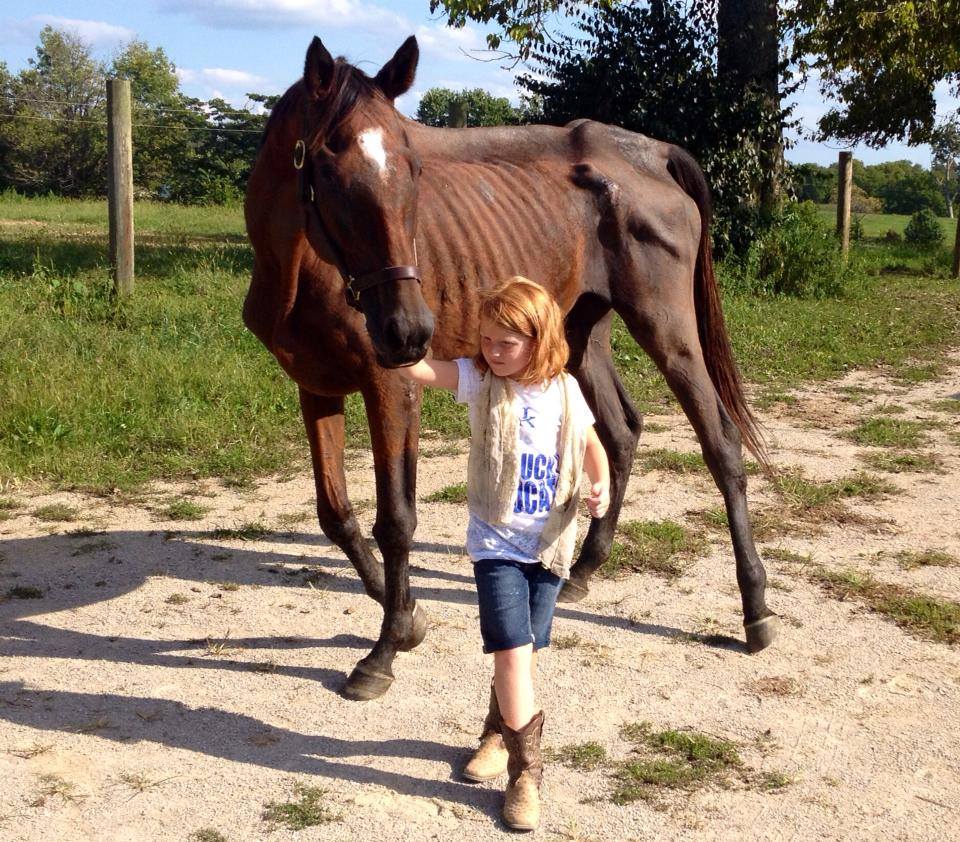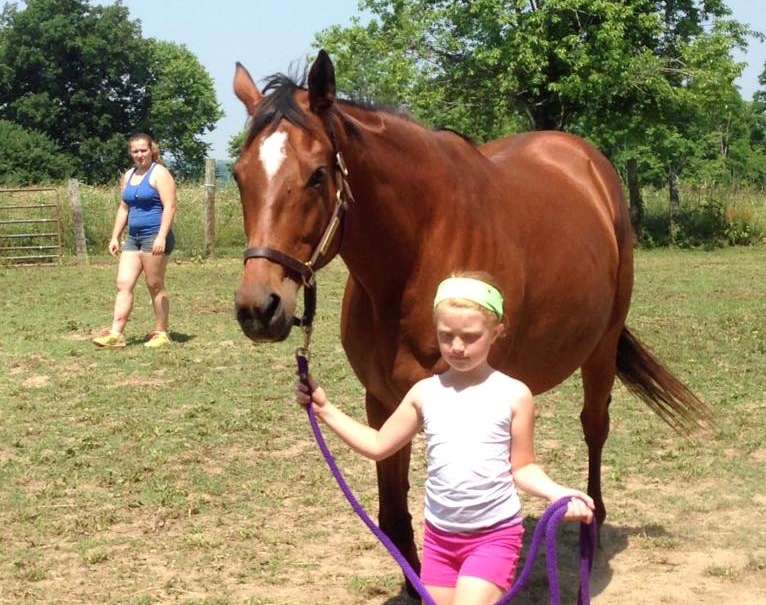
Crowning Glory, who has been renamed Hopefully Mine, was rescued by the South Florida SPCA and carefully brought back to health.
Through the years, Off-Track Thoroughbreds has chronicled stories of horses who survive against the odds.
Often times, the horses are malnourished to the point of starvation, and so depleted they appear to be hopeless cases. And yet, they survive when even the brightest minds in veterinarian medicine caution owners to prepare for the worst.
Thoroughbreds like Crowning Glory, who was rescued by the South Florida SPCA with a body condition of 1 on the Henneke Horse Body Score System, and Jo Jo Gypsy, who was rescued by Jeanne Mirabito, of Our Mims Retirement Haven in the same sorry condition, are today nearly unrecognizable as both blossom with health. (Their photos illustrate their condition).
In the first of two parts, Dr. Laurie Metcalfe, DVM associate with Rood & Riddle Equine Hospital, offers insights on the delicate process of re-feeding a starved horse.
Q: What are the critical medical tests that should be performed immediately in a horse-starvation case?
A proper physical examination by a veterinarian is vital in determining how to proceed with these horses. It is important to keep in mind that not all underweight horses are victims or abuse or neglect— occasionally they may suffer from medical conditions that result in cachexia, or the inability to maintain weight.
These include cancer, inflammatory bowel disease, parasites, heart disease, pleuropneumonia and renal (kidney) failure.
Additionally, an initial body condition score (BCS) should be established to monitor progress.
These things must be ruled out and/or treated to give these animals the best chance at recovery.
Many have poor dentition, adding to the inability or process what little food they may have had if it is a starvation case. If not being properly fed, chances are dental work has not been maintained. Therefore a thorough oral exam is crucial.
Q: And the heart also reveals much.
These horses frequently present with heart murmurs— not only because they have used all of the fat stores around the heart making it much easier to auscult valvular flow, but also because they have begun to breakdown protein from vital organs (such as the heart) for energy.
This can be a good indication of how advanced the disease process is.
Q: Why is de-worming so important?
These animals often have gastrointestinal (GI) issues secondary to the inability to digest forage properly and will often have parasites as well.
If a horse is not being fed and maintained, most likely they have not been dewormed properly. Parasites will affect these already compromised animals more significantly than a healthy horse. A fecal egg count performed prior to deworming is very important.
Q: Hair coat and feet also reveal clues to health stress.
These horses often have very poor hair coats with associated bacterial and fungal skin disease as a result of poor nutrition and compromised immune systems, which your veterinarian can also evaluate.
Feet are often in very poor condition as hoof abscesses secondary to poor immune function and lack of nutrition will complicate already neglected hooves. A complete blood count (CBC) with a chemistry can indicate significant infections or problems with specific organ systems (kidney, liver, GI).
A thorough physical exam, oral exam, fecal egg count and CBC chemistry are the things I immediately start with when initially presented with one of these cases.
Q: What evidence informs you of a horse’s chance of survival?

Hopefully Mine (JC: Crowning Glory) as she appears today. Owned by Susie Martell of Florida now, she enjoys a new lease on life.
In general, a horse that has lost 50 percent of its body weight has a poor prognosis for survival.
If a horse has a poor appetite, and is no longer interested in food as the starvation has progressed too far, chance of survival is less. These animals need to be able to help themselves when given the things they need to do so.
In addition, if a horse cannot stand, a poor/guarded prognosis is given even with aggressive, appropriate therapy. The longer the horse is recumbent, the greater the chance that it will not get back up.
That being said, all horses are individuals and will respond differently to treatment and rehabilitation—many will not do as well as expected and others will unexpectedly thrive.
Q: Are there some standard re-feeding guidelines and best practices?
Most importantly, all changes need to be implemented gradually. At first, just good quality hay, preferably a palatable alfalfa mix should be offered. Small, frequent meals, 6-8 times a day for a week or so then slowly over the next few weeks increase amount while decreasing frequency to 3-4 then 2-3 times a day.
Fresh, clean water should be available at all times as well as a salt or mineral block. Electrolyte abnormalities are not uncommon in malnourished patients.
No grain or supplemental feed should be offered until the horse is handling the hay without issue as this can complicate metabolic function.

Jo Jo Gypsy was rescued by Jeanne Mirabito of Our Mims Retirement Haven. She is pictured with Jeanne’s granddaughter.
Good quality pasture can be offered in slowly increasing amounts and can improve condition more rapidly than hay alone.
It is crucial to resist the temptation to feed them whatever they want and however much of it they want—one can literally “kill them with kindness”.
Q: What are the biggest risks to re-feeding a seriously malnourished and emaciated horse?
Abrupt re-feeding can cause metabolic abnormalities leading multi-organ failure.
Re-feeding syndrome is a metabolic complication that occurs when nutritional support is given to severely malnourished patients.
Their metabolism shifts from a catabolic to an anabolic state, with potentially fatal shifts in fluids and electrolytes.
When a horse does not get adequate calories, they initially use any fat and carbohydrate stores to supply energy for normal body functions. Once the stored source of fat and carbs are depleted, energy comes from the breakdown of protein.
Protein is the building block of many vital tissues; however, there are no protein stores in the body as there are fat and carbs. Ultimately, the malnourished body uses protein from not only muscle, but from organs such as the heart and GI tract.
Re-feeding too abruptly can “shock” these already taxed systems.
Emaciated horses have decreased gut bacteria (flora) that are necessary to digest food.
The cells that line the GI tract and produce digestive enzymes have a decreased ability to absorb feed- this is why gradual re-feeding is crucial to allow GI flora and cells to return to their previous function. Problems with this will be manifested as colic and discomfort.
Too many calories too fast can cause an insulin peak that causes electrolytes to be drawn into cells. In starved animals, electrolytes are already depleted, leaving them with little to function eventually resulting in organ system failure.
Q: Assuming the horse is responding well to a regimen, what outward signs will someone notice during the process?
It will take about two weeks to show signs of increased energy— the horse will be brighter, more interested in its surroundings and demonstrate more personality.
Heart murmurs get softer and are eventually no longer audible. Some weight gain may be noticed within a month, but 3-5 months is usually what is needed to rehabilitate to a normal weight (per AAEP Guidelines for Equine Rescue and Retirement Facilities).
Hair coat will shed and completely lose the hair in areas of previous skin disease but will grow back healthy. Feet will get stronger and healthier as well. Often while in re-feeding transition these animals will have intermittent diarrhea and abnormal fecal consistency—this will eventually normalize.
All of these are positive changes to monitor, however be careful!
Many of these horses are docile and easy to handle while emaciated become more difficult as their health improves and personality changes. Be aware of this and don’t get caught off guard—the transformation is often remarkable!
—Author’s note: Stay tuned for Part 2 of Laurie Metcalfe’s Q&A next Tuesday.




When you talked about the personality change, we are seeing this right now?with a horse we didn’t initially realize waa so malnourished when we bought him. He has gone from lethargic and depresses to almost aggressive and fiery in two weeks. We were caught off guard
I have… Just this evening found an emaciated TB dark bay in a council owned piece of scrubland… Alongside 2 normal weight horses.
Though TB poss belonging to someone else.
Tb is kind of tucked away, almost hidden from veiw.
Feet look good and trimmed.
No fat or muscle at all. Ribs and hips jutting out.Triangle shaped from behind.
Got water. No hay, minimal grass.
World horse wefare being informed.
I have photos
Just so sad..
Can I ask an additional question? I have a horse who was malnourished and successfully rehabbed. What are the longer lasting effects I can expect? What about the psychological effects? He is very anxious and rushed with his food, and I understand why. What can I do to help him? Thank you 🙂
Kate:
I have a Part 11 of her Q&A for next week. If that question isn’t answered, I will try to reach out and ask her. How long have you had your horse? Just a guess that if you’ve only had him a year, that he needs reassurance over time. Like people, some get over emotional scars faster than others. And many of us carry emotional scars our whole lives. Another thought is that when he’s ready, and if you have a program in your area, that a trust-building program using natural horsemanship might help. But, I’m just the blogger, not the expert. I’ll ask the doctor. – Sue
Thank you for your kindness and a loving heart. It is so reassuring to know that there are good people out there in the world helping those who need their help. God bless you.
Great job ro all involved.
Thank you, Susan, for a great article! People who read this will come away with the knowledge of what to do, who to call and in the end, be inspired to try!
WOW Susan – I am speechless! One of your best informative articles and so important for ALL of us to know under any circumstances. Bless the people that care enough to do this for any equine let alone an OTTB!
Both rescues look fabulous now
Great advice from Dr. Laurie Metcalfe! Thank you Susan Salk for sharing this great information with your readers and the public. It is a difficult and often frustrating process to rehab and get weight on a horse with a body scale of 1. But when you begin to see the transformation and eventually the end result of a healthy horse, your heart just swells with happiness and joy! Also thank you Susan for referencing My girl Crowning Glory(Hopefully Mine) as part of this article. It has taken almost a full year to get her to a healthy weight and has been quite a journey. I couldn’t be happier. Both Hope and Jo Jo’s Gypsy look fantastic!!!! Here’s to those who have taken on the responsibility of bringing these beautiful animals back to life and good health. And here’s to those who will in the future❤️ I look forward to reading the next part of the article. Thanks again Sue and Dr. Metcalfe
OMG…both of these are gorgeous horses, beautiful conformation. Who would have known that from the starvation condition? Great article.